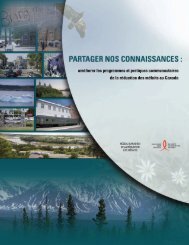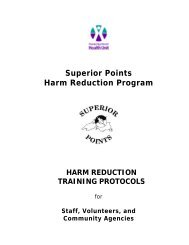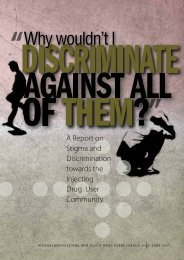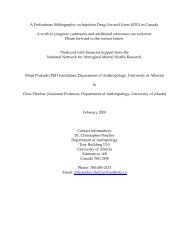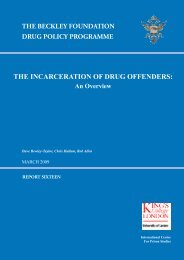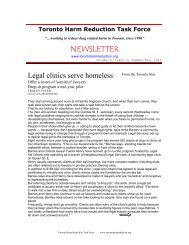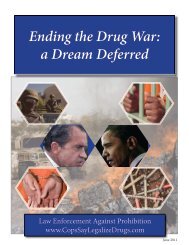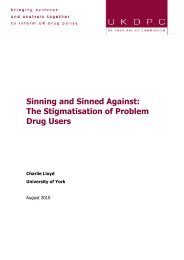Harm Reduction in Canada.pdf - Canadian Harm Reduction Network
Harm Reduction in Canada.pdf - Canadian Harm Reduction Network
Harm Reduction in Canada.pdf - Canadian Harm Reduction Network
Create successful ePaper yourself
Turn your PDF publications into a flip-book with our unique Google optimized e-Paper software.
<strong>Harm</strong> <strong>Reduction</strong> <strong>in</strong> <strong>Canada</strong>:The Many Faces of RegressionWalter Cavalieri & Diane Rileyfrom <strong>Harm</strong> <strong>Reduction</strong> <strong>in</strong> Substance Use and High‐risk Behaviour:International Policy and Practice, edited by Richard Pates & Diane Riley.Wiley‐Blackwell, London, 2012The authors dedicate this chapter to the memory of Jack Layton, friend and colleague,leader of <strong>Canada</strong>ʹs New Democratic Party, who died <strong>in</strong> August of 2011 at age 61. Inhis eloquent letter to <strong>Canadian</strong>s, released the day after he died, Jack called on us to jo<strong>in</strong>together to build on the work he left unf<strong>in</strong>ished, and he left us a guide to how to do it:ʺMy friends,ʺ he wrote, ʺlove is better than anger. Hope is better than fear. Optimismis better than despair. So let us be lov<strong>in</strong>g, hopeful and optimistic. And weʹll changethe world.ʺHistorical Background to <strong>Harm</strong> <strong>Reduction</strong> <strong>in</strong> <strong>Canada</strong>Drug PolicyThe legal framework of the current system of drug control <strong>in</strong> <strong>Canada</strong> was laid down<strong>in</strong> the early part of the 20th century. In 1908, all medic<strong>in</strong>es, as well as tobacco andalcohol, were on the way to regulation and the Opium Act created drug prohibition,the basis of the current system. An <strong>in</strong>crease <strong>in</strong> illicit drug use <strong>in</strong> the 1960ʹs and 1970ʹswas met by greatly <strong>in</strong>creased crim<strong>in</strong>alization and the associated <strong>in</strong>dividual andsocial costs. Rates of use climbed sharply through the 1960ʹs and early 1970ʹs, despitea large allocation of enforcement resources (Erickson, 1992). The stra<strong>in</strong> on thecourts, and the ris<strong>in</strong>g numbers of otherwise law‐abid<strong>in</strong>g youth be<strong>in</strong>g sentenced fordrug offences (particularly cannabis possession) created pressures for theliberalization of <strong>Canada</strong>ʹs drug laws. The Commission of Inquiry <strong>in</strong> theNon‐Medical Use of Drugs (1972, generally referred to as the Le Da<strong>in</strong> Commission)was formed <strong>in</strong> 1969 to address this grow<strong>in</strong>g concern about drug use and appropriateresponses.The Le Da<strong>in</strong> Commission described and analyzed the social costs and <strong>in</strong>dividualconsequences of the crim<strong>in</strong>alization policy and represents an important step <strong>in</strong> thedevelopment of a policy of harm reduction <strong>in</strong> <strong>Canada</strong>. Follow<strong>in</strong>g much consultation
and study, the Le Da<strong>in</strong> Commission <strong>in</strong>quiry concluded that drug prohibition results<strong>in</strong> high costs but relatively little benefit. The majority of the commissionersrecommended a gradual withdrawal from crim<strong>in</strong>al sanctions aga<strong>in</strong>st people whouse illicit drugs, along with the development of less coercive and costly alternativesto replace the punitive application of crim<strong>in</strong>al law. The Le Da<strong>in</strong> Commission servedthe role of most Royal Commissions: it delayed action on a controversial issue longenough for the public demand for action to subside. Interest <strong>in</strong> reform of drug policygradually decl<strong>in</strong>ed (S<strong>in</strong>gle, Erickson, & Skirrow, 1991). Attempts to reduce theconsequences of crim<strong>in</strong>alization met with limited success.By the mid‐1980s there was grow<strong>in</strong>g acknowledgment of the serious limitations oflaw enforcement and education <strong>in</strong> reduc<strong>in</strong>g the demand for drugs. In 1987 the<strong>Canadian</strong> federal government announced ʺAction on Drug Abuseʺ, <strong>Canada</strong>ʹs DrugStrategy. <strong>Canada</strong>ʹs Drug Strategy (CDS) gave a means to address substance use withboth supply and demand reduction strategies. The new drug strategy brought $210million <strong>in</strong> new fund<strong>in</strong>g <strong>in</strong> roughly equal amounts to enforcement, treatment andprevention programm<strong>in</strong>g and had the aim of reduc<strong>in</strong>g drug‐related harm. Itdef<strong>in</strong>ed harm as ʺsickness, death, social misery, crime, violence and economic coststo all levels of governmentʺ. <strong>Canada</strong>ʹs Drug Strategy was funded for an <strong>in</strong>itialfive‐year term end<strong>in</strong>g <strong>in</strong> April 1992 and was renewed to 1997. The <strong>Canadian</strong> Centreon Substance Abuse was founded <strong>in</strong> 1990 as part of this strategy. In its Policy andresearch Unit, Diane Riley and Eric S<strong>in</strong>gle researched and documented alternativesto drug prohibition and promoted the pr<strong>in</strong>ciples and practice of harm reductionand other evidence‐based approaches. This unit, often under criticism for itsanti‐prohibitionist stance, was shut down <strong>in</strong> 1996 as part of the demise of the drugstrategy (Oscapella & Riley, 1997). In Rileyʹs approach, what came to be calledpillars were tightly <strong>in</strong>tegrated threads, not dist<strong>in</strong>ct entities (Riley, 1993; Riley et al,1999). The term ʺDrug Strategyʺ was reapplied to the rema<strong>in</strong><strong>in</strong>g efforts <strong>in</strong> 1998, butit is a strategy without the weight, collaborators, or fund<strong>in</strong>g of the forerunners. withdrug issues be<strong>in</strong>g brought under the general umbrella of ʺpopulation healthʺ.With the <strong>in</strong>troduction of a new drug law <strong>in</strong> the 1990s, there was an opportunity toaddress some of the problems of past law and to benefit from what had been learnedfrom the experience of other countries. The new law, the Controlled Drugs andSubstances Act, however, is soundly prohibitionist; and rather than retreat<strong>in</strong>g fromthe drug war rhetoric of the past it expands the net of prohibition further still. Theproblems related to crim<strong>in</strong>aliz<strong>in</strong>g people who use illicit drugs, the social and
economic costs of this approach, and its failure to reduce drug availability have stillnot been addressed. As a result, the costs, both f<strong>in</strong>ancial and human, of licit drug userema<strong>in</strong> unnecessarily high while the costs of crim<strong>in</strong>aliz<strong>in</strong>g illicit drug use cont<strong>in</strong>ueto rise, steadily, predictably and avoidably. The result: harms <strong>in</strong>creased rather thanreduced (Oscapella and Riley, 1997).In 1994 the <strong>Canadian</strong> Foundation for Drug Policy (CFDP) was created and dur<strong>in</strong>gthe next several years this small NGO helped to br<strong>in</strong>g about some drug reform,<strong>in</strong>clud<strong>in</strong>g the legalization of medical marijuana. In 1999 members of the CFDP wrotea review of drug policy <strong>in</strong> <strong>Canada</strong> for the Senate with a view to drug policy reform(Riley, 1998). In 2000 the Senate began an <strong>in</strong>quiry <strong>in</strong>to the non‐medical use of drugsand soon after the House of Commons began its own review of drug policy. Theresults of both reviews were disappo<strong>in</strong>t<strong>in</strong>g, with the most significant be<strong>in</strong>g that theSenate called for legalization of cannabis, but there was little result<strong>in</strong>g change <strong>in</strong>policy or practice.<strong>Harm</strong> <strong>Reduction</strong> ProgrammesAs <strong>in</strong> other countries, harm reduction <strong>in</strong> various forms has been practiced forcenturies but not explicitly labelled as such. The first form of harm reduction as wedef<strong>in</strong>e it today was practiced <strong>in</strong> the early 1980s <strong>in</strong> Toronto, Ontario, <strong>in</strong> the form ofcontrolled dr<strong>in</strong>k<strong>in</strong>g programs (Riley and OʹHare, 2000). In 1987, as concerns rose <strong>in</strong>the community about the spread of HIV through <strong>in</strong>jection drug use, bleachprogrammes were started at Alexandra Park <strong>in</strong> Toronto; these developed <strong>in</strong>tosyr<strong>in</strong>ge exchange programmes <strong>in</strong> 1988 and were taken over by the City of Toronto<strong>in</strong> 1989 (Riley and McCrimmon, 1988). A grant application submitted by Jack Layton(now leader of the New Democratic Party), then Chair of the Toronto Board ofHealth, and Diane Riley to the Federal government received $11 million <strong>in</strong> AIDSfund<strong>in</strong>g over three years, <strong>in</strong>clud<strong>in</strong>g funds for syr<strong>in</strong>ge exchange and other harmreduction <strong>in</strong>itiatives. This helped to ensure low prevalence of HIV among IDU <strong>in</strong>that city (Riley, 1993, CPHA, 1994). Syr<strong>in</strong>ge exchange programmes were started <strong>in</strong>Montreal and Vancouver <strong>in</strong> 1989, and <strong>in</strong> other urban and rural communities across<strong>Canada</strong> <strong>in</strong> the follow<strong>in</strong>g years (CPHA, 1994). A number of NGOs began to conductworkshops on harm reduction and to carry out advocacy throughout <strong>Canada</strong> andthen <strong>in</strong>ternationally. In the late 1980s and early 1990s the number of methadoneprogrammes <strong>in</strong> <strong>Canada</strong> <strong>in</strong>creased significantly and became somewhat more liberal<strong>in</strong> nature.
As <strong>in</strong> many countries, the real impetus for harm reduction was the rise of HIV<strong>in</strong>fection among <strong>in</strong>jection drug users. In <strong>Canada</strong>, <strong>in</strong>jection drug use is second onlyto homosexual/bisexual activity as a means of HIV transmission <strong>in</strong> men and secondonly to heterosexual acquisition <strong>in</strong> women. These <strong>in</strong>dividuals are concentrated, forthe most part, <strong>in</strong> the metropolitan areas of larger cities, but there is <strong>in</strong>jection druguse <strong>in</strong> most urban and rural areas of <strong>Canada</strong>. In 1997 a health emergency wasdeclared as a result of the rapid <strong>in</strong>crease of HIV <strong>in</strong>fection <strong>in</strong> <strong>in</strong>jection drug users <strong>in</strong>Vancouverʹs Downtown East Side. Prevalence levels had reached more than 20percent and <strong>in</strong>cidence rates more than ten percent. In 1998, prevalence rates wereestimated at between 25 and 35 percent (Vancouver/Richmond Health Board, HIVReports; BC M<strong>in</strong>istry of Health AIDS Surveillance Reports). These rates placedVancouver <strong>in</strong> the unenviable position of hav<strong>in</strong>g the highest levels of HIV <strong>in</strong>fection<strong>in</strong> <strong>in</strong>jection drug users <strong>in</strong> the Western world. In addition, Vancouver has had thehighest levels of overdose deaths <strong>in</strong> <strong>Canada</strong>, with more than 3,000 s<strong>in</strong>ce 1991. Thehigh levels of <strong>in</strong>fection and other drug‐related problems have been l<strong>in</strong>ked to thepoverty and social dislocation of many of the residents of some of itsneighbourhoods. This outbreak was one of the ma<strong>in</strong> forces beh<strong>in</strong>d Vancouverʹsmove toward harm reduction policies and programs and sent a strong warn<strong>in</strong>gmessage to other cities <strong>in</strong> <strong>Canada</strong>, sadly, by no means always heeded (see below).Traditionally, hero<strong>in</strong> has been the ma<strong>in</strong> drug adm<strong>in</strong>istered by <strong>in</strong>jection <strong>in</strong> <strong>Canada</strong>;Talw<strong>in</strong> (a depressant) and Rital<strong>in</strong> (a stimulant) have also been popular as <strong>in</strong>jectablesat various times <strong>in</strong> different parts of the country, and are still very popular <strong>in</strong> someprov<strong>in</strong>ces. Over the last two decades, coca<strong>in</strong>e and methamphetam<strong>in</strong>e have beenused <strong>in</strong>creas<strong>in</strong>gly by <strong>in</strong>jection drug users, either on their own or <strong>in</strong> comb<strong>in</strong>ation withhero<strong>in</strong> (Riley, 2008). There is also <strong>in</strong>creas<strong>in</strong>g non‐medical use of <strong>in</strong>jectable steroidsby athletes, dancers and the general male population throughout <strong>Canada</strong>. Coca<strong>in</strong>e,<strong>in</strong> the form of crack, is the most universally used drug <strong>in</strong> <strong>Canada</strong> ‐ typically it issmoked, but it is also <strong>in</strong>jected. Prescription opiates have grown <strong>in</strong> popularity andare readily available through dealers.Rates of HIV among drug <strong>in</strong>jectors <strong>in</strong> <strong>Canadian</strong> cities range from approximately 5%to more than 30%. Some regions of <strong>Canada</strong> report higher <strong>in</strong>cidence rates, especiallyamong Natives and <strong>in</strong> correctional <strong>in</strong>stitutions (see chapter by Jurgens <strong>in</strong> thisvolume) Aborig<strong>in</strong>al peoples are overrepresented <strong>in</strong> <strong>in</strong>ner city <strong>in</strong>jection drug usecommunities and among clientele us<strong>in</strong>g <strong>in</strong>ner‐city services such as needle exchangeprograms and counsel<strong>in</strong>g/referral sites. It is important to note that Hepatitis C is ‐
a more important issue for most drug users <strong>in</strong> <strong>Canada</strong> than is HIV.Recent DevelopmentsThe current status of harm reduction <strong>in</strong> <strong>Canada</strong>, at both the policy and programmelevel, is best described as ʺ<strong>in</strong> regressionʺ. There are two types of regression;structural regression is the ʺnaturalʺ process of sanitiz<strong>in</strong>g that sets <strong>in</strong> whensometh<strong>in</strong>g radical is <strong>in</strong>stitutionalised or professionalised and becomes part of thema<strong>in</strong>stream, when it ʺcomes of ageʺ. This is a slow, <strong>in</strong>sidious type of regression. Thesecond type of regression is deliberate and swifter than the first type, and it is oftenideologically driven.Ideologically driven regression has moved <strong>Canada</strong>ʹs federal drug strategy awayfrom harm reduction. As noted above, the National Drug Strategy of 1987, as wellas its revisions <strong>in</strong> 1992 and 1998, acknowledged the existence of harm reduction.This was a somewhat brave move, even <strong>in</strong> this essentially prohibitionist andenforcement‐oriented strategy, because of <strong>Canada</strong>ʹs proximity to the United States,with its war on drugs. Good words were far more numerous than good actions, andthe majority of funds dispersed under the drug strategies cont<strong>in</strong>ued to be dedicatedto enforcement. Accord<strong>in</strong>g to the Auditor General, <strong>in</strong> 1991 95% of federalexpenditures related to illicit drugs were used for drug law enforcement, with littlesuccess to show for it. This percentage has been only slightly modified s<strong>in</strong>ce then.The impact of hav<strong>in</strong>g a ʺbalancedʺ drug strategy ‐ even if it was <strong>in</strong> name only ‐ wasambiguous. On the one hand, federal recognition of harm reduction as a viablepublic health measure gave license to supporters <strong>in</strong> the community as well as <strong>in</strong> thepublic service to engage <strong>in</strong> implement<strong>in</strong>g harm reduction policies and practices,albeit unevenly, across <strong>Canada</strong> and also gave prov<strong>in</strong>ces and municipalities theimpetus to <strong>in</strong>corporate harm reduction <strong>in</strong>to their own drug strategies. Currently,four prov<strong>in</strong>ces and two territories explicitly advocate for or <strong>in</strong>clude harm reductionas a component of their strategies, as do n<strong>in</strong>e cities and municipalities. One of thosecities is Vancouver, whose ʺFramework for Actionʺ <strong>in</strong>itiated, <strong>in</strong> 2001, <strong>Canada</strong>ʹs<strong>in</strong>fatuation with the concept of ʺFour Pillarsʺ: harm reduction, prevention, treatmentand enforcement.On the other hand, the federal governmentʹs shameless lack of reasonable supportfor harm reduction and its commitment to enforcement ma<strong>in</strong>ta<strong>in</strong>ed <strong>Canada</strong>ʹsaffection for prohibition and set up harm reduction as a lighten<strong>in</strong>g rod for
controversy. <strong>Harm</strong> reduction programs and services are always forced to provetheir worth, even <strong>in</strong> the face of overwhelm<strong>in</strong>g evidence that <strong>in</strong>deed they do work,both on a scientific level and on the level of ʺwhat is rightʺ. Core program fund<strong>in</strong>gcont<strong>in</strong>ued to be difficult to get, and little if anyth<strong>in</strong>g was done to address underly<strong>in</strong>gissues which support substance dependency: poverty, trauma, mental illness,stigma, lack of honest <strong>in</strong>formation about drugs and drug use, lack of compassion,<strong>in</strong>equity and disrespect. At the same time, harm reduction was expand<strong>in</strong>g its focuswell beyond HIV and HCV prevention, and took it upon itself address<strong>in</strong>g socialjustice and the right to health for people us<strong>in</strong>g illicit drugs, <strong>in</strong>corporat<strong>in</strong>g the bestof health promotion.In 2008, with the Liberals los<strong>in</strong>g control of govern<strong>in</strong>g <strong>Canada</strong> to neo‐conservatives,led by Stephen Harper, the duplicity and hypocrisy of surround<strong>in</strong>g harmreductionʹs place <strong>in</strong> <strong>Canada</strong>ʹs drug strategy ended. The Liberalʹs dither<strong>in</strong>g aboutharm reduction begat the wither<strong>in</strong>g that the current government is all too happy toaccelerate (Riley and Oscapella, 2006, 2007). Among its earliest actions was the PrimeM<strong>in</strong>isterʹs announcement of its $64‐million‐dollar National Anti‐Drug Strategy.The National Anti‐Drug Strategy was developed through close collaborationbetween our governmentʹs m<strong>in</strong>isters and senior bureaucrats from the Bush WhiteHouse, and was stripped of all mention of not just harm reduction <strong>in</strong> general, butof needle exchange specifically. Harper also put an end to the prior governmentʹsplan to decrim<strong>in</strong>alise possession of small quantities of marijuana and removed drugissues from the M<strong>in</strong>istry of Health, leav<strong>in</strong>g them solely under the jurisdiction of theM<strong>in</strong>istry of Justice.The government also promoted a str<strong>in</strong>gent ʺlaw ʹnʹ orderʺ agenda about crime <strong>in</strong>general, and <strong>in</strong> particular, youth and drug crime ‐ despite a drop <strong>in</strong> both the volumeand severity of crime consistent over the past five years. The Anti‐Drugʹs Strategyʹsviews are simplistic: drugs are the pr<strong>in</strong>cipal cause of crime, and the best weaponsaga<strong>in</strong>st drugs are <strong>in</strong>carceration, longer prison sentences, property seizure, andjust‐say‐no‐to‐drugs education, all of which have spotty records. Under theAnti‐Drug Strategy, 70% of the fund<strong>in</strong>g is allocated to law enforcement, 4% toprevention; 17% to treatment, and 2% to harm reduction, even though it is not listed<strong>in</strong> it.The Conservativeʹs claimed that the Liberals had put <strong>Canada</strong> on the road to drug
legalization and that they <strong>in</strong>tended to stop this (<strong>in</strong> truth, legalisation was never theLiberal agenda). Say<strong>in</strong>g that parents and police alike know that the last th<strong>in</strong>g<strong>Canada</strong> needs is more drugs on our streets, they have declared thatget‐tough‐on‐crime‐and‐crim<strong>in</strong>als policies are needed fix this; prison reformmeasures are particularly he<strong>in</strong>ous. They have vowed to end house arrests, cut backon probation, and ensure mandatory m<strong>in</strong>imum prison sentences and large f<strong>in</strong>es forʺseriousʺ drug offenders, <strong>in</strong>clud<strong>in</strong>g marijuana growers and dealers of crystal methand crack; to prevent the decrim<strong>in</strong>alization of marijuana; to beef up lawenforcement; and to seriously underm<strong>in</strong>e the rights of <strong>in</strong>carcerated people. All thesemeasures have been passed or are underway.Despite evidence that this American‐style approach has been such a disaster andthat even the Americans are retreat<strong>in</strong>g from it, a significant proportion of the<strong>Canadian</strong> electorate is embrac<strong>in</strong>g it, largely without <strong>in</strong>formed public debate. Yetthis agenda benefits no one save those <strong>in</strong>volved <strong>in</strong> the illegal trade and black marketand the prison‐<strong>in</strong>dustrial complex. Drugs are more available than ever, stronger and<strong>in</strong> greater variety, and people cont<strong>in</strong>ue to be <strong>in</strong>carcerated, get longer sentences and‐ even worse ‐ die of highly preventable diseases and conditions. Further, <strong>in</strong> <strong>Canada</strong>,the war on drugs has been conflated with its war on terrorism. <strong>Canada</strong>ʹs supportsanti‐drug operations <strong>in</strong> Afghanistan to the tune of many millions, and our troops areheavily <strong>in</strong>volved <strong>in</strong> this.Harperʹs Conservatives blatantly attack harm reduction <strong>in</strong> their policies (e.g.,tough‐on‐crime bills, cont<strong>in</strong>ually try<strong>in</strong>g to shut down the safe <strong>in</strong>jection site, Insite),and <strong>in</strong> their discourses (e.g., distribut<strong>in</strong>g pamphlets fraught with <strong>in</strong>flammatoryanti‐drug‐user and anti‐harm‐reduction messages).In the summer of 2007, staff from the <strong>Canadian</strong> <strong>Harm</strong> <strong>Reduction</strong> <strong>Network</strong> and the<strong>Canadian</strong> AIDS Society travelled from coast to coast to coast <strong>in</strong> <strong>Canada</strong>, research<strong>in</strong>gthe state of harm reduction <strong>in</strong> small‐to‐medium‐sized cities. One result of thisproject was the report Learn<strong>in</strong>g from Each Other: Enhanc<strong>in</strong>g Community‐Based<strong>Harm</strong> <strong>Reduction</strong> Programs and Practices <strong>in</strong> <strong>Canada</strong> (2008). It was found that,though programs were sometimes <strong>in</strong>sufficient and spotty, a great deal of <strong>in</strong>ventiveand effective work was be<strong>in</strong>g done. There was hope, then, that th<strong>in</strong>gs would getbetter for people us<strong>in</strong>g drugs ‐ even though it was tempered by grow<strong>in</strong>gapprehension about the direction of the new federal government.
Three years on, the balance between hope and concern has shifted. There have beenno major leaps forward <strong>in</strong> the provision of services for people who use drugs, andwe do the best we can now to ma<strong>in</strong>ta<strong>in</strong> what we have and not make waves. In somecases this may mean serv<strong>in</strong>g people <strong>in</strong>adequately or even degrad<strong>in</strong>g or underm<strong>in</strong><strong>in</strong>gharm reduction. Science is vilified, car<strong>in</strong>g is scorned, and mean‐spiritedness isbecom<strong>in</strong>g <strong>in</strong>stitutionalised. When it comes to harm reduction, we are a nation <strong>in</strong>regression.A brief overview of harm reduction across <strong>Canada</strong>The TerritoriesThe northernmost part of <strong>Canada</strong> comprises three Territories: Yukon and NorthwestTerritories and Nunavut. The land area is vast: nearly 4,000,000 square kilometres.The population is small: just over 100,000 people. In the Yukon Territory, thechallenges for harm reduction are formidable and <strong>in</strong>clude lack of anonymity, sparsepopulations over large areas, and limited fund<strong>in</strong>g. While not unlike the situationthroughout rural <strong>Canada</strong>, it is much more so, and people have come up withimag<strong>in</strong>ative solutions tailored to local needs. In Whitehorse (the capital) serviceshave a quality that is much stronger than <strong>in</strong> other parts of the country: broadcommunity collaboration. Agencies, a service club, volunteers, the local college andcommunity members work together to address the jo<strong>in</strong>t issues of drug use andpoverty. Programs are embedded <strong>in</strong> the community itself, and no one agency takesheat for problems or prejudice. Whitehorseʹs harm reduction program is operatedby a partnership of three community agencies and Yukon College. The outreach vanprogram, receives f<strong>in</strong>ancial back<strong>in</strong>g from the Territorial Government, while somelocal restaurants provide food and coffee. These collaborations mean that harmreduction is a community <strong>in</strong>itiative <strong>in</strong> which many have ownership.The territorial government allows a safer crack kit distribution program to operate,but does not fund supplies, which are paid for by the local Rotary Club. A spanner<strong>in</strong> the works is SCAN ‐ the Safer Community and Neighbourhoods program ‐ whichis territory‐wide. SCAN programs have been sprout<strong>in</strong>g up across <strong>Canada</strong>; theyencourage citizens to contact their offices through ʺsnitch l<strong>in</strong>esʺ when they suspectthat activities such as produc<strong>in</strong>g, sell<strong>in</strong>g or us<strong>in</strong>g illegal drugs, sex work, solvent useor the unlawful sale and consumption of alcohol are tak<strong>in</strong>g place <strong>in</strong> theirneighbourhood. Compla<strong>in</strong>ts are kept anonymous and result <strong>in</strong> a boldly colouredlawn or door sign on the residence of the offend<strong>in</strong>g person, <strong>in</strong>form<strong>in</strong>g all that it isunder surveillance An <strong>in</strong>vestigation by the SCAN team of law enforcement
personnel eventually takes place. ʺRemediesʺ such as clos<strong>in</strong>g down the residence,evict<strong>in</strong>g the occupants and seiz<strong>in</strong>g their assets may be applied. Alternative hous<strong>in</strong>gand support and treatment for the occupants may be offered; but, <strong>in</strong> Whitehorseoutreach workers state that most people who had been ʺmarkedʺ simply disappearand cannot be provided with services. Eviction <strong>in</strong> Whitehorse is cruel and callous.W<strong>in</strong>ter temperatures there often exceed 40 degrees Celsius below zero.British ColumbiaThe Prov<strong>in</strong>ce of British Columbia is seen by many as the leader <strong>in</strong> harm reduction<strong>in</strong> <strong>Canada</strong>. Though not necessarily an accurate assessment, it is the perception,largely because of Insite, <strong>Canada</strong>ʹs best known safe <strong>in</strong>jection site. (This is one of twosafe <strong>in</strong>jection sites <strong>in</strong> Vancouver; the other is at the Dr. Peter Centre); VANDU,<strong>Canada</strong>ʹs largest drug user group; the NAOMI trial (North American OpiateMa<strong>in</strong>tenance Initiative), which successfully addressed recalcitrant opiate addictionswith hero<strong>in</strong> or dilaudid; and the Portland Hotel Society, whose ʺ<strong>Harm</strong> <strong>Reduction</strong>Hous<strong>in</strong>gʺ program has, s<strong>in</strong>ce 1993, promoted, developed and ma<strong>in</strong>ta<strong>in</strong>edsupportive, affordable lodg<strong>in</strong>g for adult <strong>in</strong>dividuals who are considered ʺhard tohouseʺ and at the highest risk of homelessness. Their pr<strong>in</strong>cipal residents are peoplewith HIV/AIDS, substance misuse problems, forensic issues, mental illness and/orconcurrent disorders.In 2001, Donald MacPherson, Vancouverʹs Drug Policy Coord<strong>in</strong>ator unveiled<strong>Canada</strong>ʹs first urban drug strategy, Vancouverʹs ʺFramework for Actionʺ, a ʺfourpillarʺ approach: harm reduction, prevention, treatment and enforcement. Recently,MacPherson resigned his post and he is not be<strong>in</strong>g replaced. Vancouver is a majorpublic battle ground for the federal governmentʹs war on harm reduction. Theirpr<strong>in</strong>cipal focus is Incite, started <strong>in</strong> 2003, after many years of plann<strong>in</strong>g by local andnational activists. Despite its clear success <strong>in</strong> prevent<strong>in</strong>g overdoses and otherpersonal and community harms, the federal government have repeatedly tried toshut it down (see, e.g., Kerr, T et al 2004, Wood, et al 2005). The RCMP, too,campaigns aga<strong>in</strong>st Incite, contribut<strong>in</strong>g to public mis<strong>in</strong>formation. Some workershave suggested that Vancouverʹs preoccupation with Insite is imped<strong>in</strong>g thedevelopment of other, much‐needed harm reduction services, especially <strong>in</strong> thesuburbs and rural areas. Insite rema<strong>in</strong>s open, and other sites for safe <strong>in</strong>jection and<strong>in</strong>halation have been proposed <strong>in</strong> British Columbia and Quebec, but none hasmoved beyond the speculative stage.
The prov<strong>in</strong>ce is cutt<strong>in</strong>g prevention‐focussed community support for people us<strong>in</strong>gdrugs, <strong>in</strong>clud<strong>in</strong>g treatment. They have scrapped many contracts with communitysocial service agencies which work with people suffer<strong>in</strong>g from both mental illnessand addiction. In many parts of the prov<strong>in</strong>ce, outreach to people who use crack iswoefully <strong>in</strong>complete: Pyrex pipe stems are not supplied. There is considerablecommunity activism, however, around decrim<strong>in</strong>alisation of marijuana. BC has someof the most <strong>in</strong>novative harm reduction programmes for women <strong>in</strong> <strong>Canada</strong>,<strong>in</strong>clud<strong>in</strong>g Fir Square and Sheway for pregnant women and mothers.Victoria, the capital of British Columbia, has an open drug scene second only toVancouverʹs. Victoria has been without a fixed‐site needle exchange s<strong>in</strong>ce May 2008because: residents and bus<strong>in</strong>esses object and politicians claim it ʺnot readyʺ for afixed site. Syr<strong>in</strong>ges are available <strong>in</strong> two public health offices, but users tend not togo there. There is some mobile exchange organised by the drug users themselvesbut mobile services are not allowed <strong>in</strong> certa<strong>in</strong> sections of the city, <strong>in</strong>clud<strong>in</strong>g somewhere drug use is highest. Coquitlam is part of greater Vancouver; <strong>in</strong> an effort tomake it more ʺfamily‐friendly,ʺ the city will ban exotic danc<strong>in</strong>g and methadonecl<strong>in</strong>ics. In another city, Abbotsford, the council has passed an anti‐harm reductionbylaw.The PrairiesRecently, the Prov<strong>in</strong>ce of Alberta centralised its health services. Consequences of thismove <strong>in</strong>clude the loss as of local autonomy and the Non‐Prescription Needle UseInitiative, a very effective prov<strong>in</strong>cial drug and harm reduction network<strong>in</strong>g scheme.Funds, programs and staff for programs practis<strong>in</strong>g harm reduction have been cut;coord<strong>in</strong>ated services downgraded; regional needs and differences dismissed; andthe prov<strong>in</strong>ceʹs annual harm reduction conference cancelled. Programs across theprov<strong>in</strong>ce are no longer able to come together rout<strong>in</strong>ely, and many opportunities fortra<strong>in</strong><strong>in</strong>g or policy discussion have been curtailed. This has led to greater isolation,fewer mentorship opportunities, dim<strong>in</strong>ished opportunities to track trends across theprov<strong>in</strong>ce and less partnership work. A highly successful collaborative model hasbeen replaced with one based on competition among communities for scarcefund<strong>in</strong>g. Even so, Edmonton has found a way to cont<strong>in</strong>ue to support drug userorganis<strong>in</strong>g and also ma<strong>in</strong>ta<strong>in</strong> its <strong>in</strong>novative overdose‐death‐prevention programwhich provides peers with a supply of naloxone, which they can use to save thelives of people overdos<strong>in</strong>g on opiates. It is the only program of its k<strong>in</strong>d <strong>in</strong> <strong>Canada</strong>.
With<strong>in</strong> a political atmosphere that is hyper‐responsive to public op<strong>in</strong>ion, especiallythat driven by conservative family and social values it is difficult for policy makersto support harm reduction publicly, though many seem to favour it privately. Thecreation of fear is a common theme <strong>in</strong> Alberta. People pursu<strong>in</strong>g harm reductionactivities and apply<strong>in</strong>g for fund<strong>in</strong>g for programs report that almost universallyreport that they avoid words ʺharm reductionʺ.Saskatchewanʹs rates of HIV/AIDS are currently the highest <strong>in</strong> <strong>Canada</strong> ‐ 20.3 per100,000 as opposed to the national rate of 9.3, with 75% of those cases found <strong>in</strong><strong>in</strong>jection drug users. Its premier wants to halt unlimited needle distribution andmandate a limit of ten needles per visit <strong>in</strong> all its needle exchange programs, despitean earlier government‐ordered review that found the exist<strong>in</strong>g system helps curbdisease and reduce healthcare costs. He has, however, offered no new fund<strong>in</strong>g forthese <strong>in</strong>terventions. In Reg<strong>in</strong>a, Saskatchewanʹs capital city, the return rate of usedneedles is 94%, one of the highest <strong>in</strong> the world. Should the premier study whathappened <strong>in</strong> Vancouver <strong>in</strong> the 1990s, he would see how foolish and ill‐<strong>in</strong>formed hisidea is: It was tried there; and, before it was altered, Vancouver had atta<strong>in</strong>ed thehighest HIV rate of any major first‐world city. Like Vancouver, Saskatchewanʹs<strong>in</strong>jectable drug of choice is coca<strong>in</strong>e.Ontario & QuebecIn Ontario there is ambivalence about harm reduction, but it cont<strong>in</strong>ues to lead theway <strong>in</strong> <strong>Canada</strong> <strong>in</strong> the implementation of needle distribution and, <strong>in</strong> some area, crackkits. That leadership is based on a 2006 publication, Ontario Needle ExchangePrograms: Best Practice Recommendations. The application of these best practiceguidel<strong>in</strong>es is uneven, and some public health personnel still consider needleexchange as ʺenabl<strong>in</strong>gʺ. More extensive scorn is directed toward crack kitdistribution, <strong>in</strong>clud<strong>in</strong>g by a number of Medical Officers of Health. Although smallertowns and rural areas cont<strong>in</strong>ue to be very seriously under‐served, there is <strong>in</strong>creasedawareness about harm reductionʹs efficacy <strong>in</strong> medium‐sized cities such as Sudbury,Thunder Bay, K<strong>in</strong>gston and Kitchener‐Waterloo. Methadone is available across theprov<strong>in</strong>ce, though the prov<strong>in</strong>cial guidel<strong>in</strong>es for methadone treatment draw strongcriticism from clients because of their restrictiveness. There is little access formethadone treatment <strong>in</strong> locations away from cities and towns, and cl<strong>in</strong>ics still haveto fight bus<strong>in</strong>ess and residentsʹ associations over locations.The prov<strong>in</strong>ce recently completed its ten‐year mental health and addiction strategy.
It was a struggle to ensure that the voice of the drug user was <strong>in</strong>cluded at a volumeeven half that of the mental health client, and the strategy is to be accomplishedwithout any new fund<strong>in</strong>g.Even now, though most of those who provide services to people who use or at riskof us<strong>in</strong>g illicit drugs are aware of harm reduction, many donʹt understand whatharm reduction really is and neglect even its most basic pr<strong>in</strong>ciple. Worse, manyconstrue it solely as an <strong>in</strong>tervention rather than a way of work<strong>in</strong>g, which means thatboth its health promotion and social justice planks may be ignored. This narrownessis not unique to OntarioThe city of Ottawa is conservative <strong>in</strong> its approach to harm reduction; the currentpolice chief cont<strong>in</strong>ues to lobby for 1‐for‐1 needle exchange. Five years ago, led bya mayor dis<strong>in</strong>cl<strong>in</strong>ed to respect evidence, Ottawa closed its highly successful safercrack kit program. The prov<strong>in</strong>ceʹs m<strong>in</strong>istry of health subsequently stepped <strong>in</strong> andsaved it by fund<strong>in</strong>g a community health centre to take it over. Ottawa does what itmust and can do, but there is a sense that homeless people, most of whom do useillicit drugs, are no longer welcome there.Toronto has long had a vibrant harm reduction community, <strong>in</strong>itiated by acomb<strong>in</strong>ation of community activists, front‐l<strong>in</strong>e workers, people with currentdrug‐use experience, academics and even some city politicians. The AIDS <strong>Network</strong>of Toronto (later the <strong>Harm</strong> <strong>Reduction</strong> <strong>Network</strong>), established <strong>in</strong> 1987, conductededucation and provided syr<strong>in</strong>ge exchange, sett<strong>in</strong>g up <strong>Canada</strong>ʹs first needle exchange<strong>in</strong> a community hous<strong>in</strong>g project <strong>in</strong> 1988. Toronto then led the way <strong>in</strong> <strong>Canada</strong> <strong>in</strong>sett<strong>in</strong>g up decentralised needle exchanges under the leadership of Public Health.There are now approximately 30 needle exchange sites across the city, plus a mobileprogram. <strong>Canada</strong>ʹs first drug usersʹ group was established <strong>in</strong> Toronto <strong>in</strong> 1991, theFUN Group, and it is still operat<strong>in</strong>g. In 1994 the group produced <strong>Canada</strong>ʹs firstvideo on safer <strong>in</strong>ject<strong>in</strong>g, FIT, and marketed it <strong>in</strong>ternationally.It is encourag<strong>in</strong>g that Toronto has a comprehensive drug strategy and that harmreduction plays a central role <strong>in</strong> it. However, as <strong>in</strong> the now defunct federalgovernment drug strategies, no real money has ever been allocated to realiz<strong>in</strong>g thestrategyʹs potential, and harm reduction is left vulnerable. Toronto has engaged <strong>in</strong>a five‐year effort to sort out whether or not it should set up safe drug‐use rooms.<strong>Harm</strong> reduction has a high profile <strong>in</strong> the city, but it also has its opponents ‐
neighbourhood and bus<strong>in</strong>ess organisations, police and opportunistic politiciansbe<strong>in</strong>g the most prom<strong>in</strong>ent; Torontoʹs Police Service have ma<strong>in</strong>ta<strong>in</strong>ed a ʺWar onDrugsʺ mentality.Programs <strong>in</strong> urban Quebec have been dar<strong>in</strong>g and effective, largely because early onthey adopted harm reduction as a core pr<strong>in</strong>cipal and made extensive use of<strong>in</strong>digenous knowledge. <strong>Harm</strong> reduction was accepted <strong>in</strong> a full range of <strong>in</strong>stitutionaland community organizations, <strong>in</strong>clud<strong>in</strong>g the CACTUS needle exchange, one of<strong>Canada</strong>ʹs first such programs. Lately, political support for harm reduction programshas been slipp<strong>in</strong>g and fund<strong>in</strong>g more difficult to obta<strong>in</strong>. <strong>Harm</strong> reduction has beensubjected to baseless criticism from many prov<strong>in</strong>cial and municipal politicians andfund<strong>in</strong>g has been withdrawn from successful programs and services.In the Quebec legislative assembly, the deputy leader of the opposition claimed thata coca<strong>in</strong>e harm reduction <strong>in</strong>formation card produced by a lead<strong>in</strong>g Montreal agencywas promot<strong>in</strong>g coca<strong>in</strong>e use. The opposition party has criticised needle exchangeand the m<strong>in</strong>ister of health will not support the establishment of a safe <strong>in</strong>jection site.The highly praised book, Drogues: savoir plus, risquer mo<strong>in</strong>s, with over 125,000copies already <strong>in</strong> distribution, was pulled off the market: it was too friendly to harmreduction.In Quebec City, the major harm reduction program, Po<strong>in</strong>t de repères, is fight<strong>in</strong>g forits life, be<strong>in</strong>g pushed out of a high‐drug‐use neighbourhood to facilitategentrification. For many years, this neighbourhood has been the home base for alarge community of illicit drug users; Po<strong>in</strong>t de repères is be<strong>in</strong>g framed as the reasonthat these people are com<strong>in</strong>g to the neighbourhood, rather than it be<strong>in</strong>g recognisedthat the agency is <strong>in</strong> the neighbourhood because the drug users are already there.Quebec City is aga<strong>in</strong> enforc<strong>in</strong>g the law that anyone caught with drug paraphernalia(needles, pipes, etc.) will be f<strong>in</strong>ed.Atlantic Prov<strong>in</strong>cesIn these eastern‐most prov<strong>in</strong>ces (Nova Scotia; Pr<strong>in</strong>ce Edward Island; NewBrunswick; Newfoundland and Labrador), harm reduction services tend to be moreconstra<strong>in</strong>ed, and even <strong>in</strong> the cities they stay as conservative as the government, <strong>in</strong>order to ma<strong>in</strong>ta<strong>in</strong> their fund<strong>in</strong>g. The focus of needle exchange programs cont<strong>in</strong>uesto be mostly on the syr<strong>in</strong>ge itself, with access to other safer <strong>in</strong>ject<strong>in</strong>g supplies be<strong>in</strong>glimited, as are crack kits, even though the demand for them has <strong>in</strong>creased, often
surpass<strong>in</strong>g that for needles as drug‐use patterns have changed. The availability ofmethadone is far more restricted than <strong>in</strong> Ontario or Quebec. In the past few years,there has been some additional outreach <strong>in</strong>to rural areas, but it is <strong>in</strong>sufficient <strong>in</strong>coverage and scope of service provision. Satellite harm reduction sites rema<strong>in</strong>scarce, the development of networks of drug users or dealers who can distributeharm reduction equipment has not really taken place, and a culture of clean needleand disposal access is not well supported. Many people see harm reduction as ado‐goodersʹ activity that coddles people who use drugs and helps them to stayhooked, at the taxpayersʹ expense.In Nova Scotia, there is no prov<strong>in</strong>cial leadership for harm reduction. The needleexchange <strong>in</strong> the capital, Halifax, <strong>in</strong> operation s<strong>in</strong>ce 1992, still exists by grace ofdiscretionary ʺgrantsʺ, not permanent fund<strong>in</strong>g, and opportunities for shar<strong>in</strong>g<strong>in</strong>formation and ideas, develop<strong>in</strong>g prov<strong>in</strong>cial or regional strategies or provid<strong>in</strong>gbasic client support simply donʹt exist, unless it is through research projects.Program fund<strong>in</strong>g, as elsewhere, is often tied to short‐term pilot projects, a dismalpractice, with no guarantee of cont<strong>in</strong>uity for the program or the staff; ʺDeath bypilotʺ is a common joke. There is also the threat, here as elsewhere, that harmreduction services will be subsumed <strong>in</strong>to a generic mental health & addiction basket,where addiction will play second fiddle to mental health and harm reduction willall but disappear. In this scenario, while itʹs impossible to fault people for becom<strong>in</strong>gschizophrenic, itʹs easy to blame (and shame) them for becom<strong>in</strong>g drug‐dependent.The <strong>in</strong>creased presence of police around needle exchanges, as has been the case <strong>in</strong>Halifax, is om<strong>in</strong>ous. The tensions caused by this and the limitations put on thenumber of crack pipes available elevate tension and are used to ʺjustifyʺ municipalsweeps of established street communities. One Chief of Police, <strong>in</strong> Moncton, NewBrunswick, acknowledges the futility of the revolv<strong>in</strong>g door approach <strong>in</strong> whichpeople move <strong>in</strong> and out of jail and get sicker; recognis<strong>in</strong>g the efficacy of nurs<strong>in</strong>g andsocial work <strong>in</strong>terventions; he has become a proponent for harm reduction.Through all of this, Maritimers rema<strong>in</strong> pragmatic, and there is quiet support forharm reduction. There seem to be more people talk<strong>in</strong>g about harm reduction<strong>in</strong>itiatives as a practical approach to address<strong>in</strong>g the problems aris<strong>in</strong>g from illicitdrug use ‐ as long as they are not situated <strong>in</strong> their neighbourhoods. There are alsomore researchers participat<strong>in</strong>g <strong>in</strong> and foster<strong>in</strong>g community‐based research with afocus on harm reduction. This is provid<strong>in</strong>g an opportunity to tra<strong>in</strong> community
esearchers and to reach new people with the messages about what ʺleast harmʺmight mean. Because of government disda<strong>in</strong> for harm reduction some workershave become surreptitious and clandest<strong>in</strong>e <strong>in</strong> provid<strong>in</strong>g services necessary forhelp<strong>in</strong>g people stay alive until they are ready to make changes <strong>in</strong> their use ofsubstances This noble form of anarchism ma<strong>in</strong>ta<strong>in</strong>s the stigma endured by peoplewho use drugs. At the same time it makes workers themselves vulnerable andcauses burn‐out; this is a worker issue throughout <strong>Canada</strong>.At‐Risk GroupsThere are a number of groups <strong>in</strong> <strong>Canada</strong> who would benefit from additional harmreduction services. All of them have elevated rates of HIV. These <strong>in</strong>clude, but arenot limited to, youth, women, Aborig<strong>in</strong>al/First Nations people, transgender andtranssexual persons, and prisoners. Abst<strong>in</strong>ence‐only approaches are widespread,despite their demonstrated shortcom<strong>in</strong>gs.Women, particularly those who work <strong>in</strong> the sex trade, need special programs; butfew exist. The most effective are those few run by current or former sex‐tradeworkers, most of which are <strong>in</strong> a constant struggle for fund<strong>in</strong>g, especially now thatʺfamily valuesʺ are once aga<strong>in</strong> <strong>in</strong> the ascendancy, and the rights of women are be<strong>in</strong>gsubverted. Many women do not know how to <strong>in</strong>ject drugs properly. This rendersthem dependent on their partners, who use this as a means of control and todisallow them from mak<strong>in</strong>g essential life and safety choices; this situation could berectified through safe drug use sites. Pregnant women and mothers also needprograms which address their needs; there are far too few of these <strong>in</strong> <strong>Canada</strong>. Ofthose programs that do exist, some of the best programs are <strong>in</strong> Vancouver andToronto; these programs, too, are at risk.Transgendered people are the most severely marg<strong>in</strong>alised and least wellunderstood sexual m<strong>in</strong>ority; they donʹt fit <strong>in</strong> traditional agencies and are oftenmocked, stigmatised and dismissed because of who they are. They are also at veryhigh risk of drug‐related harm, <strong>in</strong>clud<strong>in</strong>g HIV/AIDS and Hepatitis C. There hasbeen little if any change <strong>in</strong> their status with<strong>in</strong> the communities they <strong>in</strong>teract with,and they receive no recognition from most governments; agencies who work withthem struggle for fund<strong>in</strong>g.Prisoners are one of the highest risk groups for <strong>in</strong>jection‐related communicablediseases, especially HIV/AIDS and Hepatitis C. Yet, healthcare on the <strong>in</strong>side is far
from the equivalent of that on the outside. Corrections <strong>Canada</strong> closed down asuccessful safer tattoo<strong>in</strong>g program <strong>in</strong> its prisons. It steadfastly refuses to considermak<strong>in</strong>g new needles available to prison <strong>in</strong>mates, despite constant pressure fromcommunity groups over the past two decades and despite the fact that prisonsyr<strong>in</strong>ge programs have been successfully implemented elsewhere. It is not thatCorrections <strong>Canada</strong> denies that <strong>in</strong>mates use drugs and that, as a consequence, someget <strong>in</strong>fected with HIV or HCV while they are <strong>in</strong>carcerated; <strong>in</strong> fact, they admit <strong>in</strong>meet<strong>in</strong>gs (but not on paper) that such <strong>in</strong>fection is known to occur <strong>in</strong> their<strong>in</strong>stitutions. It is likely that this situation will only change when legal action is taken(as occurred with methadone availability); a number of NGOs are work<strong>in</strong>g on alegal challenge (for more details on prisons <strong>in</strong> <strong>Canada</strong> and around the world, seechapter by Jurgens <strong>in</strong> this volume).Most Aborig<strong>in</strong>al and First Nations communities cont<strong>in</strong>ue to embrace and promotean abst<strong>in</strong>ence‐based approach to drug use issues, despite all evidence that itstreatment and tools do not work for the majority of people who attempt them or onwhom they are imposed. <strong>Canadian</strong> Aborig<strong>in</strong>als have very high rates of HIV andHepatitis C, suicide and premature death, <strong>in</strong>tense and unbearable poverty, andextreme levels of <strong>in</strong>carceration: the prison system is the new residential school.Homeless Aborig<strong>in</strong>al people <strong>in</strong> <strong>Canadian</strong> cities may receive the benefit of harmreduction programm<strong>in</strong>g. Most live <strong>in</strong> rural and remote parts of <strong>Canada</strong>, where theextent of harm, if there is any, is usually <strong>in</strong> the form of secondary needle exchangeand little else. Some Aborig<strong>in</strong>al leaders recognise that harm reduction could fit <strong>in</strong>totraditional th<strong>in</strong>k<strong>in</strong>g and practices, but most donʹt.; there is much work to be done<strong>in</strong> this area.ConclusionChanges <strong>in</strong> the practice of social work over the past decades shed light on thestructural reduction regression tak<strong>in</strong>g place <strong>in</strong> harm reduction <strong>in</strong> <strong>Canada</strong>. Earlysocial work was a magnet for progressive reformers with a strong commitment tosocial justice, actualised through social action. The ability to show <strong>in</strong>dependence ofth<strong>in</strong>k<strong>in</strong>g and commitment to justice were the qualities that made the traditionalsocial worker a ʺprofessionalʺ. By the 1950s, social work had virtually desertedidealistic <strong>in</strong>tellectualism and <strong>in</strong> the process rel<strong>in</strong>quished the utopian vision thatguided early practitioners. It moved away from its vision of social justice, to anarrow preoccupation with methods and skills. Increas<strong>in</strong>gly, social work strove tofit the client to the system rather than be concerned with the reduction of <strong>in</strong>equality
and social <strong>in</strong>justice which had subverted the clientʹs life <strong>in</strong> the first place.Incrementally and <strong>in</strong>eluctably, through professionalization social workers distancedthemselves from the people they worked with. Social work became ma<strong>in</strong>stream,<strong>in</strong>creas<strong>in</strong>gly rout<strong>in</strong>ised and standardised, with an emphasis on expert‐driven,quantitative‐research‐based practice that stressed standardized, ritualistic,empirically‐tested forms of treatment ‐ ʺBest Practicesʺ ‐ and where research andtheory drove practice across the board, top‐down. By and large, social workers haveearned a poor reputation with people on the street through los<strong>in</strong>g their connectionwith the fieldʹs radical roots and buy<strong>in</strong>g <strong>in</strong>to the new professionalism.There is evidence that a similar process of regression is tak<strong>in</strong>g place <strong>in</strong> harmreduction, driven by ʺexpertsʺ, once aga<strong>in</strong> the people <strong>in</strong> power, the gate‐keeperswho have committed themselves to ma<strong>in</strong>ta<strong>in</strong><strong>in</strong>g their status at the expense of theother. Will harm reduction <strong>in</strong> <strong>Canada</strong> cease to be user‐driven and become distancedand impersonal? The answer at the moment would be ʺyesʺ.In certa<strong>in</strong> communities, harm reduction has already become part of ʺthe systemʺ;while not necessarily a bad th<strong>in</strong>g, we must rema<strong>in</strong> watchful. As it moves <strong>in</strong>toma<strong>in</strong>stream organisations, academia and public policy, harm reduction is given asuit and a haircut, made presentable and told to behave. Act<strong>in</strong>g with<strong>in</strong> a temple ofpower, as part of the establishment, harm reduction can perpetuate the structure ofdom<strong>in</strong>ation by emphasiz<strong>in</strong>g the enforcement of social control and order and gett<strong>in</strong>g<strong>in</strong>dividuals to fit <strong>in</strong>to society, rather than promot<strong>in</strong>g social welfare, respond<strong>in</strong>g tosocietal changes and respect<strong>in</strong>g peopleʹs human needs ..In this paradigm, the mostprofoundly disenfranchised users of illicit drugs are further marg<strong>in</strong>alised,stigmatised and neglected <strong>in</strong> the race to make them meet the providersʹ expectationsof what a client is and how a client must behave <strong>in</strong> order to get help.In a publication from the 1990s, Ontarioʹs Centre for Addiction and Mental Healthdescribed harm reduction as the best alternative to try ʺwhen efforts to treat, preventor punish addiction problems have not succeededʺ. Second best ‐ to punishment?The director of a street‐based youth agency funded to run a harm reduction programrefuses to allow needle exchange to be done by her staff because ʺit will give thewrong messageʺ. Another states that she doesnʹt allow needle exchange on site,because the clients know that she is opposed to their <strong>in</strong>ject<strong>in</strong>g drugs. <strong>Harm</strong>reduction for whom?
Methadone Ma<strong>in</strong>tenance Programs (MMT) ‐ at least <strong>in</strong> Ontario ‐ have become bigbus<strong>in</strong>ess, with quasi‐franchise operations located around the prov<strong>in</strong>ce. Though thishas made MMT more accessible, programs have not been consistent <strong>in</strong> offer<strong>in</strong>g thesupportive services or atmosphere which would make them effective. Manypatients are very dissatisfied with the treatment they receive, refer to MMT as aʺcash cowʺ for doctors who run the cl<strong>in</strong>ics, and see methadone itself as ʺliquidhandcuffsʺ, not just because of restrictive guidel<strong>in</strong>es but also because, as they report,it is difficult to get the prescribersʹ support when they express the desire to taper offit.In the area of research, the promotion of and reliance on pilot projects can beharmful to participants, especially when follow‐up is not sufficiently thought out.In the above‐mentioned NAOMI project, even those whose lives had been turnedaround by hav<strong>in</strong>g been prescribed hero<strong>in</strong> were taken off it at the end of the projectand referred to MMT programs. A criterion for acceptance <strong>in</strong> NAOMI was evidenceof repeated failures with MMT. Clearly both harm reduction research ethics andMMT are areas for future study.What may keep <strong>Canadian</strong> harm reduction honest and effective is the <strong>in</strong>clusion ofpeople with the lived experience of drug use <strong>in</strong> all phases of policy developmentand programm<strong>in</strong>g, from design through delivery through evaluation and research.This occurs <strong>in</strong> vary<strong>in</strong>g degrees across <strong>Canada</strong>, and cont<strong>in</strong>ues to give harm reductionits authenticity and edge.<strong>Harm</strong> reductionʹs regression <strong>in</strong> <strong>Canada</strong> is part of a larger context of the federalgovernmentʹs demonisation of drugs and the people who use them. This is awell‐funded propaganda campaign, which appeals to fear, prejudice and greed. Asa result, we are experienc<strong>in</strong>g a value shift which is deeply upsett<strong>in</strong>g and does notaugur well for harm reduction, the well‐be<strong>in</strong>g of people who use illicit drugs or forany marg<strong>in</strong>alised people. How do we account for the public embrace of currentneo‐conservative propaganda? Is it simply a case of unenlightened self‐<strong>in</strong>terest anda shortage of compassion? Is it a temporary aberration, or is it a radical change <strong>in</strong><strong>Canadian</strong> temperament?We do know this: those who work with people who use drugs, as both clients andallies, must double and re‐double our efforts to ensure that the ga<strong>in</strong>s we had madeare not forever lost; that harm reduction atta<strong>in</strong>s its rightful place among the ways
we use to address drug issues, not as a stand‐alone ʺpillarʺ but as what <strong>in</strong>forms allsubstance‐related programm<strong>in</strong>g and work. This means that we give full attentionto the consequences of what we do, <strong>in</strong>clud<strong>in</strong>g the un<strong>in</strong>tended ones. Access to harmreduction services is both a health right and a human right. And rights foroppressed people are an anathema to our current government which ‐ forideological reasons ‐ ignores not merely rights but also science. The result:ʺregression to the meanʺ ... <strong>in</strong> both senses of the term.ReferencesAlexander, B. (1998) Refram<strong>in</strong>g <strong>Canada</strong>ʹs ʺDrug Problemʺ, Policy Options 19(8),p30<strong>Canadian</strong> <strong>Harm</strong> <strong>Reduction</strong> <strong>Network</strong>. (2008) Learn<strong>in</strong>g from Each Other:Enhanc<strong>in</strong>g Community‐Based <strong>Harm</strong> <strong>Reduction</strong> Programs and Practices <strong>in</strong><strong>Canada</strong>, Toronto, CHRN, www.canadianharmreduction.com/project/<strong>in</strong>dex.php<strong>Canadian</strong> Public Health Association, (1994), Needle Exchange <strong>in</strong> <strong>Canada</strong>, SavoirFaire, Ottawa, CPHA.Centre for Addiction and Mental Health (CAMH)http://www.camh.net/Public_policy/Public_policy_papers/harmreductionbackground.html. Retrieved February 24th, 2011.Ontario M<strong>in</strong>istry of Health (2006) Ontario Needle Exchange Programs: BestPractice Recommendations, Toronto, OMH.Oscapella, E., Riley, D.M. (1997), <strong>Canada</strong>ʹs new drug law: Some implications forHIV/AIDS prevention <strong>in</strong> <strong>Canada</strong>, The International Journal of Drug Policy, 7( 3),180‐182.Riley, D.M. (1993), The policy and practice of harm reduction, Ottawa, <strong>Canadian</strong>Centre on SubstanceRiley, D.M. (1998) Drug policy <strong>in</strong> <strong>Canada</strong>, paper written as background paper for
the Senate of <strong>Canada</strong> Committee on Drug Policy Reform, Ottawa, Senate of<strong>Canada</strong>,Riley, D.M. (2008) Amphetam<strong>in</strong>e Use <strong>in</strong> <strong>Canada</strong>, <strong>in</strong> Pates, R. and Riley, D.M.Interventions for Amphetam<strong>in</strong>e Misuse, Blackwell, Oxford.Riley, D.M, McCrimmon, M. (1988) AIDS Prevention for Substance AbuseTreatment Programs: A <strong>Canadian</strong> Approach. Toronto: AIDS <strong>Network</strong> ofToronto.Riley, D.M., OʹHare, P. (2000) <strong>Harm</strong> <strong>Reduction</strong>: History, Def<strong>in</strong>ition and Practice<strong>in</strong> Inciardi, J. and Harrison, L. (Eds.), <strong>Harm</strong> <strong>Reduction</strong> and Drug Control, Sage,California, 1‐26.Riley, D.M., Oscapella, E. (2006) Drug Policy <strong>in</strong> <strong>Canada</strong>: A Decade of Dither<strong>in</strong>g.Paper presented at 17th International Conference on the <strong>Reduction</strong> of DrugRelated <strong>Harm</strong>, Vancouver, April.Riley, D.M., Oscapella, E. (2007) Drug Policy <strong>in</strong> <strong>Canada</strong>: From Dither<strong>in</strong>g toWither<strong>in</strong>g, Paper presented at the 18th International Conference on Drug Related<strong>Harm</strong>, Warsaw, May.Riley, D., Sawka, E., Conley, P., Hewitt, D., Mitic, W., Poul<strong>in</strong>, C. Room. R., S<strong>in</strong>gle,E, Topp, J. (1999) <strong>Harm</strong> <strong>Reduction</strong>: Concepts and Practices, Substance Use andMisuse, 34(1), 9‐24.S<strong>in</strong>gle, E., Erickson, P., Skirrow, J. (1991) Drugs and public policy <strong>in</strong> <strong>Canada</strong>,Rand Conference on American and European Drug Policies, Wash<strong>in</strong>gton, May.Vancouver/Richmond Health Board, HIV Reports; BC M<strong>in</strong>istry of Health AIDSSurveillance Reports 1992‐2009.Wood, E., Kerr, T., Small, W., Li, K., Marsh, D.C., Montaner, J.S., Tyndall, M.W. (2004) Changes <strong>in</strong> public order after the open<strong>in</strong>g of a medically supervised safer<strong>in</strong>ject<strong>in</strong>g facility for illicit <strong>in</strong>jection drug users. Can. Medical Association J. 171,731‐734.



